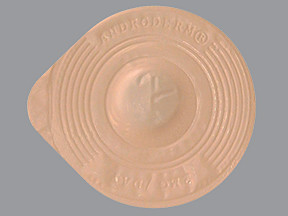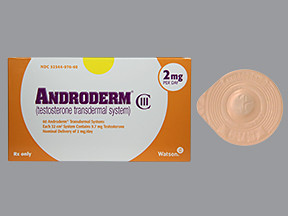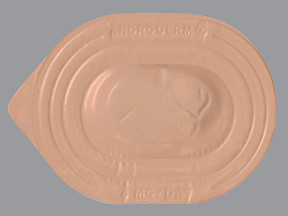TESTOSTERONE - TRANSDERMAL
PHONETIC PRONUNCIATION: (tess-TOSS-ter-own)
COMMON BRAND NAME(S): Androderm
GENERIC NAME(S): testosterone
Uses
USES: This medicated patch contains testosterone. It is used for hormone replacement in men who are not able to produce enough testosterone (e.g., hypogonadism). This medication is absorbed through the skin, enters your bloodstream, and helps your body reach normal testosterone levels. Testosterone helps the body to develop and maintain the male sexual characteristics (masculinity), such as a deep voice and body hair. It also helps to maintain muscle and prevent bone loss, and is necessary for natural sexual ability/desire. This drug should not be used by women.
How to use TESTOSTERONE - TRANSDERMAL
HOW TO USE: Read the Patient Information Leaflet provided by your pharmacist before you start using testosterone and each time you get a refill. If you have any questions regarding the information, consult your doctor or pharmacist. There are many testosterone products available for use on the skin. They may have different amounts of testosterone and may not have the same effects. Read the dosing instructions carefully for each product. Do not change products without asking your doctor or pharmacist. Apply to a dry, clean area of skin on the back, abdomen, upper arms, or thighs. Do not apply the patch to skin that has been treated with a topical ointment because doing so may decrease the amount of testosterone that your body will absorb. The patch site must not be oily or irritated. Do not place on the scrotum or on bony areas such as the shoulders or hips. To use the patch, remove the protective backing to expose the sticky surface. Immediately place the patch with the sticky side down on clean, dry skin, usually once nightly or as directed by your doctor. Wear the patch for 24 hours, then replace it with a new patch. Be sure to apply the patches to a different area each day. Wait 7 days before applying a patch to the same area of skin. The patch may be worn during sex. Wait at least 3 hours after application before showering, swimming, or other contact with water. Heavy exercise or sweating may loosen the patch or make it fall off. If the patch comes loose, press around the edges of the patch to secure it in place. If the patch falls off, see Missed Dose section. To discard a patch, fold it so the adhesive side is on the inside. Place the folded patch in the pouch from which the new patch is taken and discard it in the trash. Use this medication regularly in order to get the most benefit from it. To help you remember, use it at the same time each night. Misuse or abuse of testosterone can cause serious side effects such as heart disease (including heart attack), stroke, liver disease, mental/mood problems, abnormal drug-seeking behavior, or improper bone growth (in adolescents). Do not increase your dose or use this drug more often or for longer than prescribed. When testosterone is misused or abused, you may have withdrawal symptoms (such as depression, irritability, tiredness) when you suddenly stop using the drug. These symptoms may last from weeks to months. Inform your doctor if your condition persists or worsens.
Side Effects
Precautions
Interactions
Overdose
Images

- color
- peach
- shape
- round
- imprint
- ANDRODERM and logo and 2MG/DAY

- color
- peach
- shape
- round
- imprint
- ANDRODERM and logo and 2MG/DAY

- color
- peach
- shape
- round
- imprint
- ANDRODERM and LOGO and 4MG/DAY

- color
- peach
- shape
- round
- imprint
- ANDRODERM and LOGO and 4MG/DAY
Reviews
Faq for TESTOSTERONE - TRANSDERMAL
Transdermal testosterone refers to a method of administering testosterone hormone through the skin using patches or gels. It allows for the hormone to be absorbed directly into the bloodstream.
Transdermal testosterone is used to treat conditions associated with low testosterone levels, such as hypogonadism. It can help increase energy levels, improve muscle mass, enhance sexual function, and improve overall well-being.
Transdermal testosterone patches contain the hormone, which is slowly released into the bloodstream through the skin. The patches are usually applied to clean, dry areas of the body, such as the abdomen, back, upper arms, or thighs, and replaced as directed by a healthcare provider.
Transdermal testosterone offers several advantages over other forms of testosterone administration. It provides a steady release of hormone, avoids the first-pass metabolism by the liver, and allows for more convenient dosing compared to injections.
As with any medication, transdermal testosterone may have potential side effects. These can include skin reactions at the application site, increased red blood cell count, breast enlargement, acne, hair loss, mood changes, and prostate problems. It is important to discuss any concerns or possible risks with a healthcare provider.
The effects of transdermal testosterone can vary from person to person. Some individuals may start to experience improvements in symptoms within a few weeks, while others may take longer. It is important to follow the prescribed dosage and consult with a healthcare provider for guidance.
Transdermal testosterone is primarily used in men with low testosterone levels. However, in some cases, it may be prescribed for women to treat certain medical conditions. The dosage and duration of use will vary based on individual needs, and it is crucial to consult with a healthcare provider before using testosterone therapy in women.
Certain precautions should be followed when using transdermal testosterone, such as avoiding contact with others at the application site and ensuring proper disposal of patches or gels. It is also essential to notify healthcare providers about any existing medical conditions or medications being taken to avoid interactions or complications.
It is important to consult with a healthcare provider before discontinuing transdermal testosterone. Abruptly stopping testosterone therapy can lead to a rapid decline in hormone levels, which may cause withdrawal symptoms or a worsening of symptoms associated with low testosterone. Proper guidance should be sought to gradually taper off the treatment if needed.
Disclaimer
IMPORTANT: HOW TO USE THIS INFORMATION: This is a summary and does NOT have all possible information about this product. This information does not assure that this product is safe, effective, or appropriate for you. This information is not individual medical advice and does not substitute for the advice of your health care professional. Always ask your health care professional for complete information about this product and your specific health needs.
No Reviews Yet